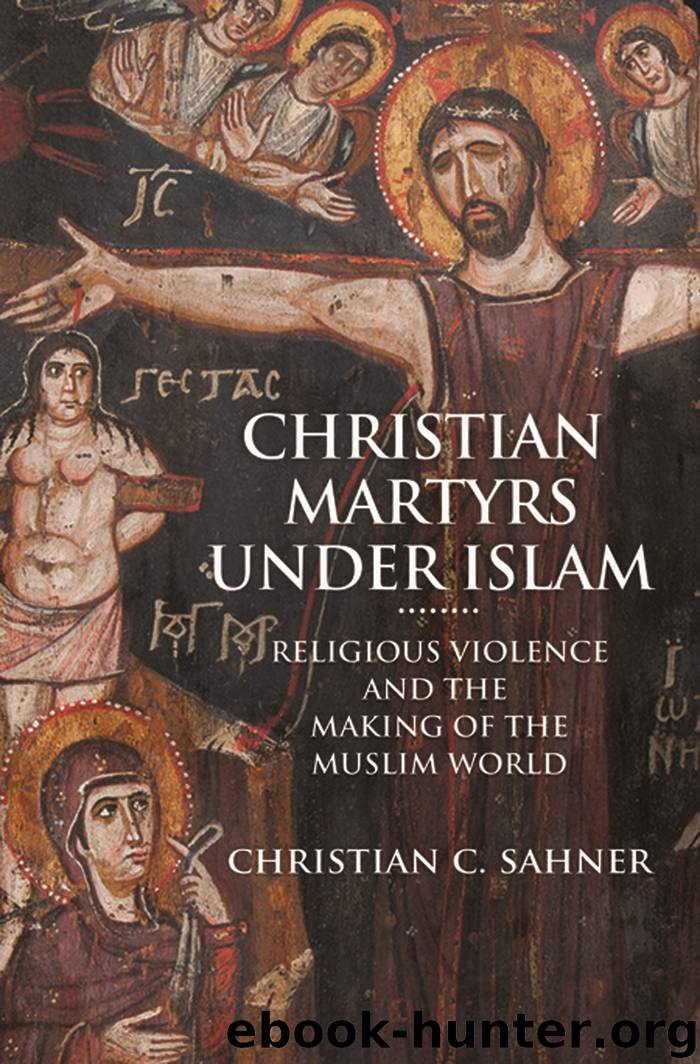Christian Martyrs Under Islam by Sahner Christian C

Author:Sahner, Christian C.
Language: eng
Format: epub
Publisher: Princeton University Press
Published: 2018-03-04T16:00:00+00:00
II. QURʾANIC PUNISHMENTS AGAINST THE MARTYRS
If Umayyad and ʿAbbasid officials treated martyrs with caution and clemency before sentencing, they usually treated them with decisiveness and fury afterward. The tortures they employed were grisly and ferocious. They were designed not only to punish criminals but also to shock a public that might be tempted to mimic them. Although the punishments of the Umayyads and ʿAbbasids were unforgiving by modern standards, there was a clear method to them: in many instances, they followed the prescriptions of Islamic criminal law, which in turn were shaped by certain passages in the Qurʾan and ḥadīth.
One very detailed guide for capital punishment is the so-called Ḥirāba Verse (Q. al-Māʾida 5:33), which outlines a suite of penalties for those found guilty of ḥirāba, the crime of inciting war against God and His prophet. Khaled Abou El Fadl has argued that the ambiguity of the verse allowed for a wide array of offenses to be lumped together under the umbrella of “brigandage.”46 Among the most important of these were apostasy and blasphemy. The verse is worth quoting in full:
The recompense of those who wage war against God [yuḥāribūna ʾllāha] and His messenger and strive to spread corruption in the land [wayasʿawna fī ʾl-arḍ fasādan] is that they be killed or crucified or have their hands and feet cut off on alternate sides [tuqaṭṭaʿ aydīhim wa-arjuluhum min khilāfin], or they shall be expelled from the land. That shall be their degradation in this world, and in the hereafter, they shall have a terrible torment.
Medieval Muslim exegetes identified different historical contexts for the revelation of this verse.47 One leading tradition states that it was revealed when a group of shepherds complained to Muḥammad that the sedentary life in Medina was no longer to their liking.48 Therefore, the Prophet lent them several camels and his mawlā Yasār and bade them farewell into the desert. Instead of following his instructions, however, the shepherds stole the camels, killed Yasār, and apostatized from Islam. The Prophet reacted by exiling, amputating, blinding, crucifying, killing, and, according to some reports, burning them.49
During the medieval period, the Ḥirāba Verse was considered one locus classicus of Islamic penal law. Despite its prominence in Muslim legal sources, it is not clear from these texts how or even whether the verse was implemented in everyday life. Christian hagiography, however, provides underappreciated evidence that the verse was indeed used to punish religious dissidents and, what is more, that this began at an early date. The impact of the verse is clearest in the Life of Peter of Capitolias, in which Umayyad officials are shown applying an array of punishments lifted directly from the Qurʾan.50 On the first day of his torture, Peter’s tongue was removed. On the second day, his right hand and left foot were amputated, and after a day’s rest, his left hand and right foot were cut off, seemingly in accordance with the Ḥirāba Verse. Finally, he was taken outside the city and crucified. Similar punishments also befell Rogelius and Servusdei, who committed blasphemy in a mosque in Córdoba in September 852.
Download
This site does not store any files on its server. We only index and link to content provided by other sites. Please contact the content providers to delete copyright contents if any and email us, we'll remove relevant links or contents immediately.
| Hadith | History |
| Law | Mecca |
| Muhammed | Quran |
| Rituals & Practice | Shi'ism |
| Sufism | Sunnism |
| Theology | Women in Islam |
The History of Jihad: From Muhammad to ISIS by Spencer Robert(2564)
Nine Parts of Desire by Geraldine Brooks(2325)
The Turkish Psychedelic Explosion by Daniel Spicer(2313)
The First Muslim The Story of Muhammad by Lesley Hazleton(2217)
The Essential Rumi by Coleman Barks(1987)
1453 by Roger Crowley(1956)
The Last Mughal by William Dalrymple(1829)
Trickster Travels: A Sixteenth-Century Muslim Between Worlds by Davis Natalie Zemon(1813)
God by Aslan Reza(1610)
Muhammad: His Life Based on the Earliest Sources by Martin Lings(1605)
by Christianity & Islam(1594)
A Concise History of Sunnis and Shi'is by John McHugo(1545)
Magic and Divination in Early Islam by Emilie Savage-Smith;(1498)
No God But God by Reza Aslan(1489)
The Flight of the Intellectuals by Berman Paul(1461)
Art of Betrayal by Gordon Corera(1399)
Nothing to Envy by Barbara Demick(1383)
What the Qur'an Meant by Garry Wills(1359)
Getting Jesus Right: How Muslims Get Jesus and Islam Wrong by James A Beverley & Craig A Evans(1307)
